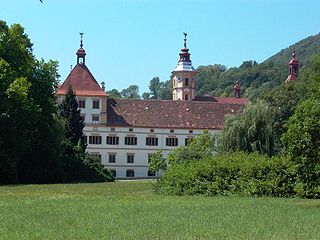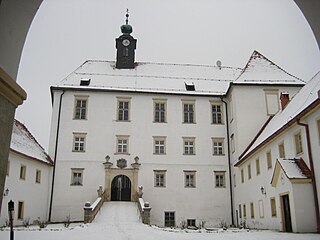Biography
The exact date of birth of Balthasar Eggenberger has been lost but he was born the son of Ulrich Eggenberger sometime in the early to mid-15th century. Like most successful men of the era, Balthasar displayed the contrary character of being, on the one hand, an unscrupulous and ambitious merchant, while on the other, being extremely pious. In 1451, to help secure the salvation of his immortal soul, he established the Eckennperger Stift. This was a hospital for the poor to which he later funded the addition of a small Chapel of All Saints and a family crypt. He was a cunning businessman who laid the foundations for the ascension of the merchant house to a noble house through his friendship with king Matthias Corvinus of Hungary. Although Corvinus was an arch-rival of Frederick III, Holy Roman Emperor, Balthasar also succeeded in the court of the emperor as his chief financier and master of the imperial mint. In 1460 Balthasar bought land on the western outskirts of the town of Graz and established the family residence there with the minting business as well as dedicating a Gothic chapel to the Virgin Mary which was recognized in a papal indulgence dated 30 May 1470. But, like Jacques Coeur, Eggenberger's fall from power when he lost favor with the emperor was as dramatic as his rise through his friendship with Matthias Corvinus had been.
Origin of the Eggenberg Coat of arms
The earliest known references to a coat of arms for the House of Eggenberg can be traced back to 1479. The coat-of-arms consists of a shield with three crowned ravens bearing a crown in their beaks. The ravens are thought to have been included as a reference to the King of Hungary, Matthias Corvinus, whose last name in Latin translates as "raven" and who likely granted the merchant the already noble coat of arms. [1] The coat of arms appears at various sites throughout central Europe that once were in the possession of the Eggenberg's. This includes on Balthasar's tombstone, contrary to all convention of the time for those not born into the nobility. This tombstone can be seen today in the Gothic chapel dedicated to the Virgin Mary at the heart of Schloss Eggenberg alongside the more-than-500-year-old Eggenberger altarpiece which Balthasar commissioned for his private chapel.
Mint master and financier to the emperor
In the 1450s Balthasar became financier to Frederick III finally establishing the family business of minting somewhere along the Sackstraße in Graz. The emperor deeded him land and, by 1460, he had established the family residence at the "Castrum Eckenperg" on the western outskirts of Graz. As a private entrepreneur leasing the business of minting the imperial currency from the emperor, Eggenberg made a profit only if the value of the coins as currency was higher than the cost of production. When the emperor raised taxes or prices or the cost of the lease, this cut into Eggenberger's profits. Therefore, around 1459, as a profit oriented business man in the days of protocapitalism, he reduced the amount of silver in the coins to such a low level that the coins became nearly worthless; all the while Eggenberger managed to amass a large private fortune. The people took to calling the worthless coins "Schinderling" and farmers would no longer accept them as currency. This precipitated a financial collapse and forced the emperor to attempt to seize Eggenberger, who had heard about the warrant and fled with very large sums of money in that time, nearly 40,000 pound, to Venice in the early part of 1460. However, Eggenberger and the emperor came to some sort of arrangement, the exact details of which have been lost to history, and in May 1460 Eggenberger returned to the family residence in Graz. He once again took up operations as the master of the mint for the emperor. He was, however, not able to stay within the good graces of the emperor for reasons that remain a mystery even today and died in the dungeons of the Schlossberg in 1493. [2]

Graz is the capital city of the Austrian state of Styria and second-largest city in Austria after Vienna. As of 1 January 2021, it had a population of 331,562. In 2018, the population of the Graz larger urban zone (LUZ) stood at 652,654, based on principal-residence status. Graz is known as a college and university city, with four colleges and four universities. Combined, the city is home to more than 60,000 students. Its historic centre (Altstadt) is one of the best-preserved city centres in Central Europe.
Marcus Valerius Messalla Corvinus was a Roman general, author, and patron of literature and art.

The ducat was a gold or silver coin used as a trade coin in Europe from the later Middle Ages until as late as the 20th century. Many types of ducats had various metallic content and purchasing power throughout the period. The gold ducat of Venice gained wide international acceptance, like the medieval Byzantine hyperpyron and the Florentine florin, or the modern British pound sterling and the United States dollar.

Ślepowron is a Polish coat of arms. It was used by several szlachta families in the times of the Polish–Lithuanian Commonwealth. From the fifteenth century, the descendants of the Ślepowron family began to use names taken from their lands. This led to many different surnames being created within one family. The Ślepowron coat of arms is unique in Polish heraldry, in that it is the only coat of arms which is indicative a common origin of individual families, that is, the de Ślepowron, or Korwin, family. Wawrzęta Korwin de Ślepowron is the oldest known ancestor of the family, although the family's oral traditions claim that they descend from Marcus Valerius Corvus, a Roman general.

Korwin is a Polish coat of arms. It was used by several szlachta families in the times of the Polish–Lithuanian Commonwealth.

Prince Hans Ulrich von Eggenberg was an Austrian statesman, a son of Seyfried von Eggenberg, Lord of Erbersdorf (1526-1594), and great-grandson of Balthasar Eggenberger. He was a prominent member of the House of Eggenberg and gained the title of Duke of Krumau.
A calendar house is a house that symbolically contains architectural elements in quantities that represent the respective numbers of days in a year, weeks in a year, months in a year and days in a week. For example, Avon Tyrrell House in Hampshire was built with 365 windows, 52 rooms, 12 chimneys, 7 external doors, and 4 wings. This style was developed during the Elizabethan era and was also prevalent during the Victorian period.

The Universalmuseum Joanneum is a multidisciplinary museum with buildings in several locations in the province of Styria, Austria. It has galleries and collections in many subject areas including archaeology, geology, paleontology, mineralogy, botany, zoology, history, art and folk culture. It is the oldest museum in Austria as well as the largest universal museum in central Europe with over 4.5 million objects in 13 departments and 12 locations in the Styrian cities of Graz, Stainz, Trautenfels, and Wagna. To reflect this status and its growth over the last two centuries, as well as to present a more recognizable image internationally, the Landesmuseum Joanneum was officially renamed to Universalmuseum Joanneum on 10 September 2009.

Eggenberg is the 14th city district of Graz in the Austrian province of Styria. It borders to the districts of Lend and Gries in the east and to the Plabutsch mountain in the west. The name originates from the Eggenberg palace and its founding family the House of Eggenberg.

Eggenberg Palace in Graz, is the most significant Baroque palace complex in the Austrian province of Styria. With its preserved accouterments, the extensive scenic gardens, as well as some special collections from the Universalmuseum Joanneum housed in the palace and surrounding park, Schloss Eggenberg ranks among the most valuable cultural treasures of Austria. Eggenberg Palace is situated at an elevation of 381 meters on the Western edge of the city. Its architectural design and the still visible imprint of centuries of history continue to bear witness to the vicissitude and patronage of the one-time mightiest dynasty in Styria, the House of Eggenberg.

Ruprecht von Eggenberg was an Austrian colonel-general from the Duchy of Styria in Inner Austria, part of the Holy Roman Empire. He was a member of the Eggenberger family and cousin of Prince Hans Ulrich von Eggenberg.
Schinderling was a popular name for the pfennigs with a sharply decreased content of fine silver from the time around 1457 to 1460, which were in circulation mostly in the region of Inner Austria.

Joseph Hueber,, was a significant Austrian baroque master builder who studied under Johann Lukas von Hildebrandt.

Eggenberg was the name of an Austrian noble family from Styria, who achieved princely rank in the 17th century. The family's last male heir died in 1717, bringing an end to the House of Eggenberg.

Herren von Graben, also named von (dem) Graben, vom Graben, Grabner, Graben von (zum) Stein, and ab dem Graben was the name of an old Austrian noble family.

Hans Adam Weissenkircher was an Austrian Baroque painter and court painter of the Prince Johann Seyfried von Eggenberg in Graz.

Giovanni Pietro de Pomis was an Italian painter, medailleur, architect and fortress master builder. His works show a marked influence of late-Mannerism.
Anna Maria Princess of Eggenberg, née Brandenburg-Bayreuth (born 30 December 1609 in Bayreuth; died 8 May 1680 in Ödenburg) was a Margravine of Brandenburg-Bayreuth and, by marriage Johann Anton I von Eggenberg, a Fürstin (princess) of Eggenberg.

Gornja Radgona Castle is a castle in Gornja Radgona, Slovenia.

Raaba-Grambach is a market town in the district Graz-Umgebung in Styria, Austria since 2015. It was created as part of the Steiermärkische Gemeindestrukturreform of Styria at the end of 2014, dissolving the towns Raaba and Grambach. One complaint from both communities against merging was raised at the Constitutional Court but ended unsuccessfully.
















